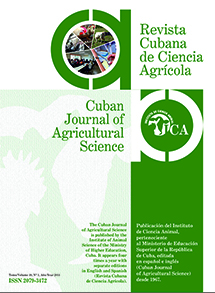Characterization of the edaphic mesofauna in five grassland agroecosystems of Granma province, Cuba
Contenido principal del artículo
Resumen
The edaphic mesofauna performs essential functions in the soil such as the recycling of nutrients and formation of its microstructure. The objective of this research was to characterize the edaphic mesofauna in five grassland agroecosystems of Granma province, Cuba. To this end, contrasting agroecosystems were selected in terms of soil type, grassland and productive purpose (“Estación de Pastos”, “Ojo de agua”, "El Triángulo", "El Progreso" and "Cupeycito"). The pitfall traps were used, with a 0.003 % detergent solution. The individuals were extracted and counted and placed in vials, with 70 % ethanol, for later identification. Individuals
belonging to two classes, four orders, six families and seven genera were found. The Collembola order was the best represented with five genera. Only in the third sampling there was a significant influence of the season detected on some of the studied variables, specifically for each agroecosystem. The Shannon index showed values lower than 1.35; while the dominance indexes showed values close to or higher than 0.5 in most cases. It is concluded that the richness and abundance of the edaphic mesofauna in the studied grassland agroecosystems was low and very variable in both climatic periods. Individuals belonging to the trophic
categories of predators and detritivores were found which showed a variable relative abundance, in each agroecosystem and sampling performed; except in the “Estación de Pastos” where there was a predominance of predators.
Key words: acari, collembolans, grasses, soils, pitfall traps
belonging to two classes, four orders, six families and seven genera were found. The Collembola order was the best represented with five genera. Only in the third sampling there was a significant influence of the season detected on some of the studied variables, specifically for each agroecosystem. The Shannon index showed values lower than 1.35; while the dominance indexes showed values close to or higher than 0.5 in most cases. It is concluded that the richness and abundance of the edaphic mesofauna in the studied grassland agroecosystems was low and very variable in both climatic periods. Individuals belonging to the trophic
categories of predators and detritivores were found which showed a variable relative abundance, in each agroecosystem and sampling performed; except in the “Estación de Pastos” where there was a predominance of predators.
Key words: acari, collembolans, grasses, soils, pitfall traps
Detalles del artículo
Cómo citar
Chávez Suárez, L., Estrada Prado, W., Labrada Hernández, Y., Rodríguez García, I., & Herrera Villafranca, M. (2019). Characterization of the edaphic mesofauna in five grassland agroecosystems of Granma province, Cuba. Cuban Journal of Agricultural Science, 53(2). Recuperado a partir de https://mail.cjascience.com/index.php/CJAS/article/view/890
Sección
Ciencia de los pastos y otros cultivos
Aquellos autores/as que tengan publicaciones con esta revista, aceptan los términos siguientes:
- Los autores/as conservarán sus derechos de autor y garantizarán a la revista el derecho de primera publicación de su obra, el cuál estará simultáneamente sujeto a la Licencia Creative Commons Attribution-NonCommercial 4.0 International (CC BY-NC 4.0) que permite a terceros compartir la obra siempre que se indique su autor y su primera publicación esta revista. Bajo esta licencia el autor será libre de:
- Compartir — copiar y redistribuir el material en cualquier medio o formato
- Adaptar — remezclar, transformar y crear a partir del material
- El licenciador no puede revocar estas libertades mientras cumpla con los términos de la licencia
Bajo las siguientes condiciones:
- Reconocimiento — Debe reconocer adecuadamente la autoría, proporcionar un enlace a la licencia e indicar si se han realizado cambios. Puede hacerlo de cualquier manera razonable, pero no de una manera que sugiera que tiene el apoyo del licenciador o lo recibe por el uso que hace.
- NoComercial — No puede utilizar el material para una finalidad comercial.
- No hay restricciones adicionales — No puede aplicar términos legales o medidas tecnológicas que legalmente restrinjan realizar aquello que la licencia permite.
- Los autores/as podrán adoptar otros acuerdos de licencia no exclusiva de distribución de la versión de la obra publicada (p. ej.: depositarla en un archivo telemático institucional o publicarla en un volumen monográfico) siempre que se indique la publicación inicial en esta revista.
- Se permite y recomienda a los autores/as difundir su obra a través de Internet (p. ej.: en archivos telemáticos institucionales o en su página web) antes y durante el proceso de envío, lo cual puede producir intercambios interesantes y aumentar las citas de la obra publicada. (Véase El efecto del acceso abierto).
